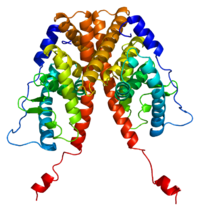
Photo from wikipedia
Surgical management for cervical malformation remains as the main therapeutic challenge for gynecologists. A theoretical alternative is to generate a bioengineered uterus cervix, which requires scaffold structure and appropriate cellular… Click to show full abstract
Surgical management for cervical malformation remains as the main therapeutic challenge for gynecologists. A theoretical alternative is to generate a bioengineered uterus cervix, which requires scaffold structure and appropriate cellular constituents. Here, human uterine cervical tissue was decellularized with detergents to produce an acellular scaffold that retained extracellular matrix (ECM), characterized through histochemical studies and DNA assessments. Recellularized scaffold was then established by decellularized scaffold reseeding with adipose-derived stem cells (ADSCs) isolated from rats. We tested these bioengineering samples in a rat model of partial cervical defect and found that recellularized scaffold improved regeneration abilities of the uterine cervix, promoted better vascularization, and achieved positive pregnancy outcomes. These results suggest that decellularized human uterine cervical scaffold combined with ADSCs could be used for uterine cervical regeneration and provide insights into treatments for cervical malformation.
Journal Title: Journal of Immunology Research
Year Published: 2022
Link to full text (if available)
Share on Social Media: Sign Up to like & get
recommendations!